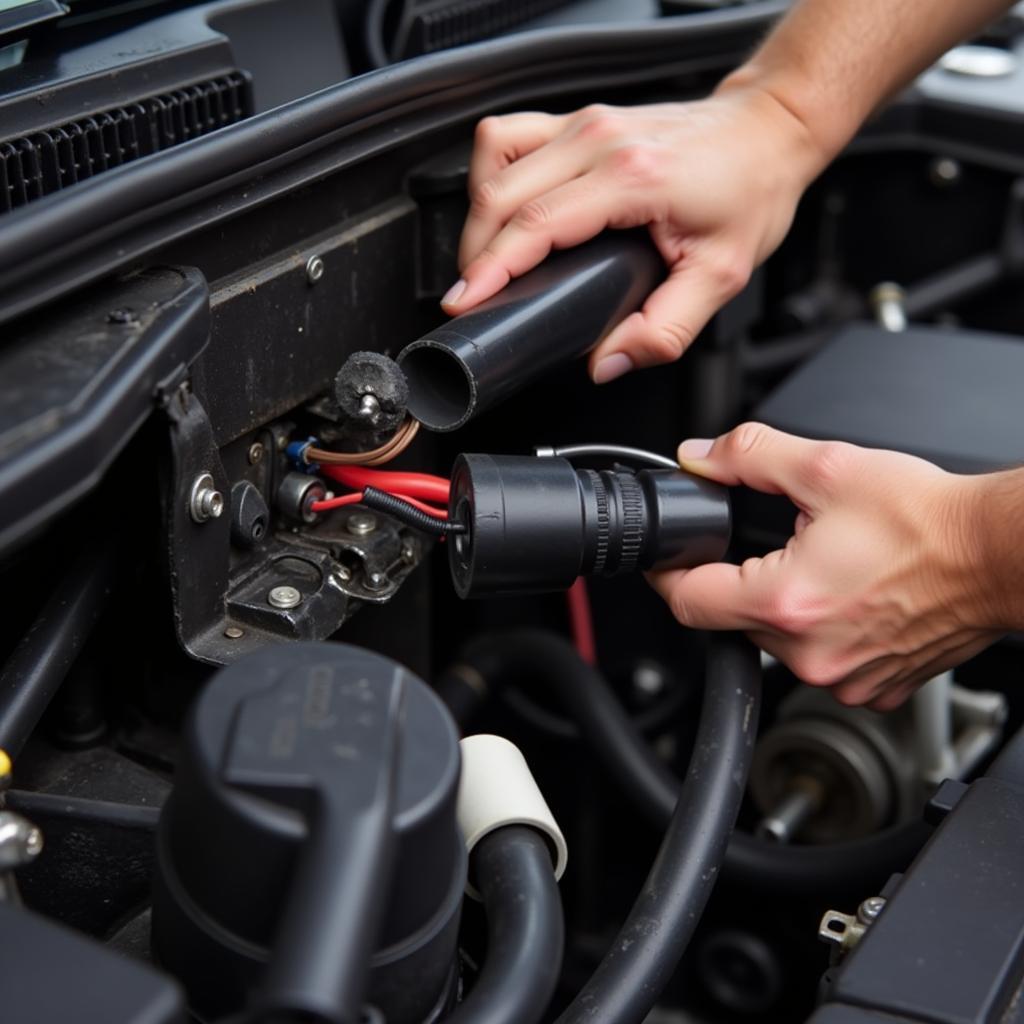A grounding problem in your car can cause a whole host of electrical issues, from dimming headlights to a malfunctioning radio. Knowing How To Check Car For Grounding Problem is an essential skill for any car owner or mechanic. This article will guide you through the process of identifying and resolving grounding issues, ensuring your vehicle’s electrical system runs smoothly. Let’s dive in and learn how to troubleshoot these often-frustrating problems. If you’re having trouble with your car radio tuner, check out this helpful resource: car radio tuner problem.
Understanding Car Grounding
The ground wire in a vehicle’s electrical system completes the circuit, allowing electricity to flow back to the battery after powering a component. A poor ground connection disrupts this flow, leading to various electrical malfunctions. Think of it like a water pipe: if the pipe is clogged, the water can’t flow properly. Similarly, a bad ground restricts the flow of electricity.
What Causes Grounding Problems?
Several factors can contribute to grounding issues. Corrosion is a common culprit, as it can build up on the ground wire terminals and connections, impeding the flow of electricity. Loose or damaged wires are another potential cause. Sometimes, the ground wire itself can break or become disconnected from the chassis or the component it’s grounding. Vibrations and exposure to the elements can also contribute to these problems.
 Checking ground connection with a multimeter
Checking ground connection with a multimeter
Signs of a Grounding Problem
Identifying a grounding problem can be tricky, as the symptoms can be diverse and intermittent. Some common signs include:
- Dim or flickering headlights, especially when other electrical components are in use
- Electrical components working erratically or intermittently
- Strange noises or static coming from the car stereo
- Difficulty starting the engine
- Dashboard warning lights illuminating unexpectedly
Experiencing issues with your car amp’s ground wire? This article may help: car amp ground wire problem.
How to Check Car for Grounding Problem: A Step-by-Step Guide
- Gather your tools: You’ll need a multimeter, a test light, and some basic hand tools.
- Inspect the battery terminals: Check for any corrosion or loose connections. Clean the terminals with a wire brush if necessary.
- Check the ground straps: Locate the ground straps connecting the battery to the engine block and the chassis. Ensure they are securely fastened and free of corrosion.
- Use a multimeter: Set your multimeter to the ohms setting. Connect one lead to the negative battery terminal and the other to a clean metal point on the chassis or engine block. A reading close to zero indicates a good ground. A high reading suggests a problem.
 Visual inspection of ground wires
Visual inspection of ground wires
- Use a test light: Connect the clip of the test light to the positive battery terminal. Touch the probe to various ground points in the electrical system. A bright light indicates a good ground. A dim or flickering light suggests a problem.
- Trace the ground wires: Follow the ground wires from various components to their connection points on the chassis. Look for any breaks, corrosion, or loose connections.
Fixing a Grounding Problem
Once you’ve identified the source of the grounding problem, fixing it is usually straightforward. Tighten any loose connections, clean corroded terminals, and replace any damaged wires. Ensure all ground connections are secure and free of corrosion for a reliable electrical system. Learn more about common ground wire problems here: ground wire car problems.
“A good ground is crucial for any vehicle’s electrical system,” says John Smith, a seasoned automotive electrician with over 20 years of experience. “A simple loose connection can cause a cascade of problems, so regular checks are essential.”
How to Prevent Grounding Problems
Regular maintenance can help prevent grounding problems. Periodically inspect and clean battery terminals and ground connections. Apply a dielectric grease to the terminals to prevent corrosion. Also, ensure all wiring is securely fastened and protected from damage.
Conclusion
Knowing how to check car for grounding problem can save you time, money, and frustration. By following the steps outlined in this article, you can diagnose and fix grounding issues effectively. A well-maintained grounding system is essential for a reliable and safe vehicle. Having trouble with your car in the winter? This resource may be helpful: car problems in winter. For questions or assistance, contact AutoTipPro at +1 (641) 206-8880 or visit our office at 500 N St Mary’s St, San Antonio, TX 78205, United States.
FAQ
- What is a car ground wire? A ground wire completes the electrical circuit by providing a path for electricity to return to the battery.
- What are the most common signs of a bad ground? Dim headlights, flickering lights, and malfunctioning electrical components are common indicators.
- Can a bad ground cause my car not to start? Yes, a bad ground can disrupt the starter motor circuit, preventing the engine from starting. Experiencing issues with your mini car radio? Check this out: mini car radio problems.
- How do I test a ground wire with a multimeter? Set the multimeter to ohms, connect one lead to the negative battery terminal, and the other to the ground point being tested. A low reading indicates a good ground.
- What should I do if I find a corroded ground connection? Clean the connection with a wire brush and apply dielectric grease to prevent future corrosion.
- How often should I check my car’s grounding system? It’s a good idea to inspect the grounding system during regular maintenance checks, at least twice a year.
- Can a bad ground cause damage to other electrical components? Yes, a poor ground can cause voltage fluctuations that can damage sensitive electronic components.






Leave a Reply